Arm Announces Neoverse V1, N2 Platforms & CPUs, CMN-700 Mesh: More Performance, More Cores, More Flexibility
by Andrei Frumusanu on April 27, 2021 9:00 AM EST- Posted in
- CPUs
- Arm
- Servers
- Infrastructure
- Neoverse N1
- Neoverse V1
- Neoverse N2
- CMN-700
PPA & ISO Performance Projections
We’ve noted about the microarchitectural changes in the new V1 and N2 processors, as well as their IPC improvements, but it’s important to actually put things into context of the actual performance and power requirements to reach those figures. Arm presented an ISO-process node figures of what we can expect out of the designs:
Starting off, we’re presented with a refresher of where exactly the Neoverse N1 was projected to end up. Back in 2019, the company had noted that an N1 core with 1MB L2 would take roughly 1.4mm² of area, and use up to 1.8W at 3.1GHz (TSMC 7nm node projection).
We’ve generally seen more conservative implementations (Graviton2) and more aggressive implementations (Altra Q) of the N1, but Arm states that their original presilicon projections ended up within 10% of the actual silicon performance figures of the respective products.
Compared to an N1, the V1 is meant to achieve 50% higher IPC, or 1.5x its predecessor while maintaining the same frequency capabilities.
What’s important to note on the slide here is that Arm is stating that power efficiency ranges from 0.7x to 1x that of the N1. Reversing the calculation for power usage increases, we actually end up with a 1.5x to 2.14x increase, which is actually quite significant. Arm also notes that the core is 1.7x larger than the N1, which is also a significant figure.
SiPearl’s Rhea chip was the first publicly known Neoverse V1 design and it features 72 cores on a N6 process node. The V1 core’s vastly increased power consumption means that it’s going to be incredibly hard to achieve similar clock frequencies while remaining in the similar 250W TDP range such as that of a current-gen top-end 80-core Altra chip, so either the core will have higher TDPs, or running at lower frequencies.
Arm also projects further non-ISO process performance figures which we’ll cover just a bit later, but there the company showcases a reference design of the V1 with 96 cores on 5nm at 2.7GHz. This means that whilst the microarchitecture seemingly would have the same frequency capabilities, the much higher power consumption of the core puts a practical limit onto the maximum frequency of any such larger core count designs.
The Neoverse N2 seems a more appropriate design. Only losing out 10% IPC versus the V1, its power consumption is targeted to be only 1.45x higher than that of an N1, meaning efficiency lands in at an almost equal 96%. The area usage here is also only 1.3x that of an N1.
So generally speaking, the N2 seems to be a linear increase in performance over the N1 – both in performance and power. While this is not a regression in efficiency (well a small one at least), it does actually mean that in terms of frequency and end-performance targets, new N2 designs require larger generational process node improvements for actual vendors to be able to actually achieve the larger IPC and performance improvements that the new microarchitectures are promising.
I take note again of situations and workloads on the Ampere Altra where we’ve seen that there’s lots of workloads where the chip operates at below the TDP because the CPUs are underutilised. If an N2 design would be able to raise performance in such workloads, and more heavily throttle itself in higher demanding high utilisation workloads, it would still mean a net positive performance benefit even regardless of process node progresses. It’s a balance and situation that will be interesting to see how it plays out in eventual Neoverse N2 products.
In terms of absolute IPC improvements, Arm also disclosed a more varied set of workloads and what to expect out of the V1 and N2.
For the V1, the IPC improvements are roughly 50% median, with SPEC CPU essentially ending up at this figure. Arm made emphasis that there’s a set of workloads that are able to take advantage of SVE and the increased vector execution width of the V1 microarchitecture to achieve IPC improvements in excess of 100-125%, which is quite impressive.
The N2’s median IPC increase lands at a median of 32%, with SPEC CPU at roughly those marketed 40% figure. The high-end isn’t as high as that of the V1, but still in excess of +50% IPC.
Finally, Arm also posted estimated figures for the components of SPEC CPU 2017, where we see the generational improvements be relatively even across the workloads, with a few exceptions where the V1’s larger characteristics come into play. There’s also workloads such as 541.leela_r where the N2 actually leads the V1, and Arm explained this by the fact that the N2 is actually a newer microarchitecture with further front-end improvements that aren’t found on the V1.


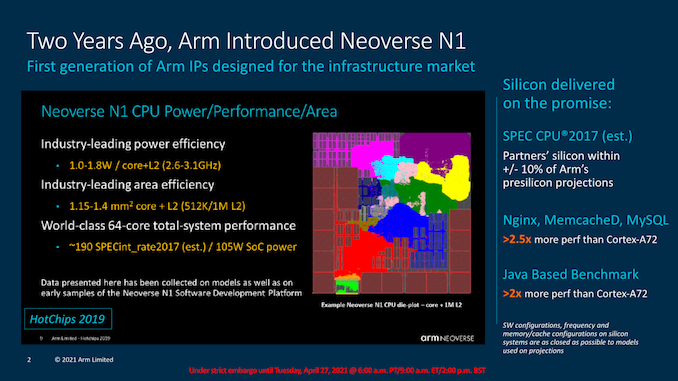
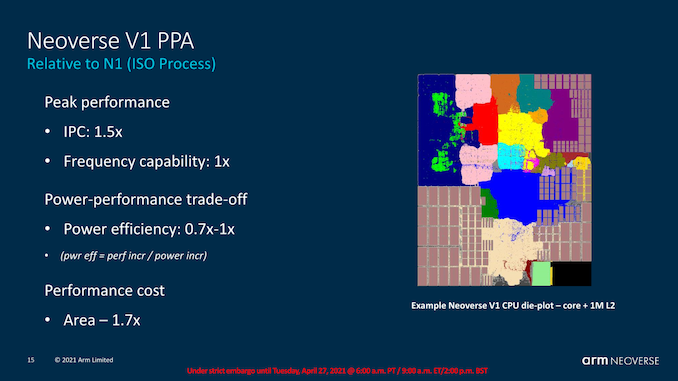
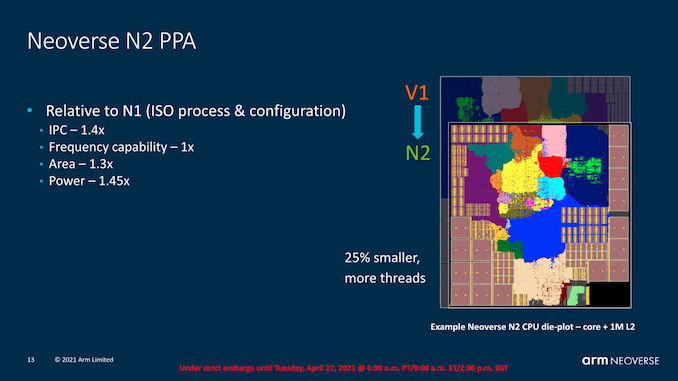
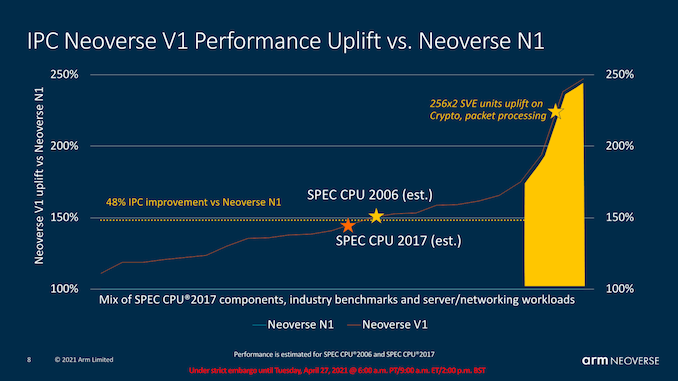
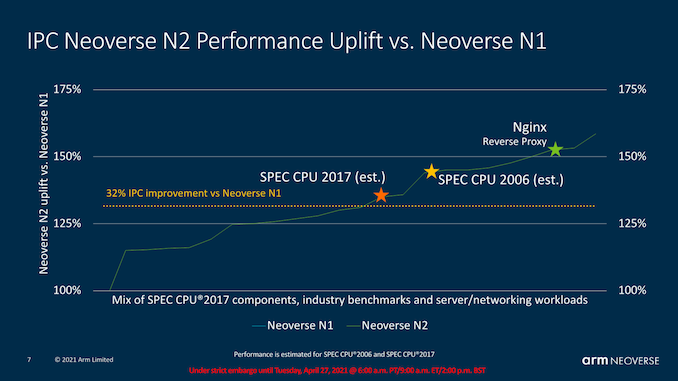
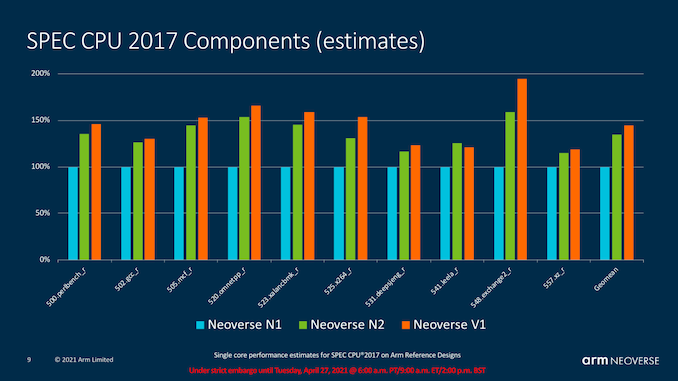








95 Comments
View All Comments
Dug - Tuesday, April 27, 2021 - link
Now is when I wish ARM was publicly traded.mode_13h - Tuesday, April 27, 2021 - link
Well, you could buy NVDA, under the assumption the acquisition will go through.dotjaz - Thursday, April 29, 2021 - link
SoftBank is already publicly traded on the Tokyo Stock Exchange. Why rely on NVIDIA buyout which for all likelihood won't happen any time soon if at all.mode_13h - Thursday, April 29, 2021 - link
> SoftBank is already publicly traded on the Tokyo Stock Exchange.They also invested heavily in WeWork, when it was highly over-valued. I have no idea what other nutty positions they might've taken, but I think it's not a great proxy for ARM just due to its sheer size.
cjcoats - Tuesday, April 27, 2021 - link
As an environmental modeling (HPCC) developer: what is the chance of putting a V1 machine on my desk in the foreseeable future?Silver5urfer - Tuesday, April 27, 2021 - link
Never. Since there has to be an OEM for these chips to put in DIY and Consumer machines, so far except the HPE's A64FX ARM there's no way any consumer can buy these ARM processors and that is also highly expensive over 5 digit figure. And then the drivers / sw ecosystem comes into play, there's passion projects like Pi as we all know but they are nowhere near the Desktop class performance.ARM Graviton 2 was made because AWS wants to save money on their Infrastructure, that's why their Annapurna design team is working there. Simply because of that reason Amazon put more effort onto it AND the fact that ARM is custom helps them to tailor it to their workloads and spread their cost.
Altra is niche, Marvell is nowhere near as their plans was to make custom chips on order. And from the coverage above we see India, Korea, EU use custom design licensing for their HPC Supercomputer designs.
Then there's a rumor that MS is also making their own chips, again custom tailored for their Azure, Google also rumored esp their Whitechapel mobile processor (it won't beat any processor on the market that's my guess) and maybe their GCP oriented own design.
These numbers projection do look good vs x86 SMT machines finally to me after all these years, BUT have to see how they will compete once they are out vs 2021 HW is the big question, since if these CPUs outperform the EPYC Milan technically AWS should replace all of them right ? since you have Perf / Power improvements by a massive scale. Idk, gotta see. Then the upcoming AMD Genoa and Sapphire Rapids competition will also show how the landscape will be.
SarahKerrigan - Tuesday, April 27, 2021 - link
If they don't replace all the x86 systems in AWS with ARM, that *must* mean Neoverse is somehow secretly inferior, right??Or, you know, it could mean that x86 compatibility matters for a fair chunk of the EC2 installed base, especially on the Windows Server side (which is not small) but on Linux too (Oracle DB, for instance, which does not yet run on ARM.)
Silver5urfer - Tuesday, April 27, 2021 - link
That was a joke.Spunjji - Friday, April 30, 2021 - link
Was it, though? Schrodinger's Joke strikes again.Raqia - Tuesday, April 27, 2021 - link
Maybe not an V1 but you could probably get a more open high performance ARM core than the Apple MX series pretty soon:https://investor.qualcomm.com/news-events/press-re...
"The first Qualcomm® Snapdragon™ platforms to feature Qualcomm Technologies' new internally designed CPUs are expected to sample in the second half of 2022 and will be designed for high performance ultraportable laptops."